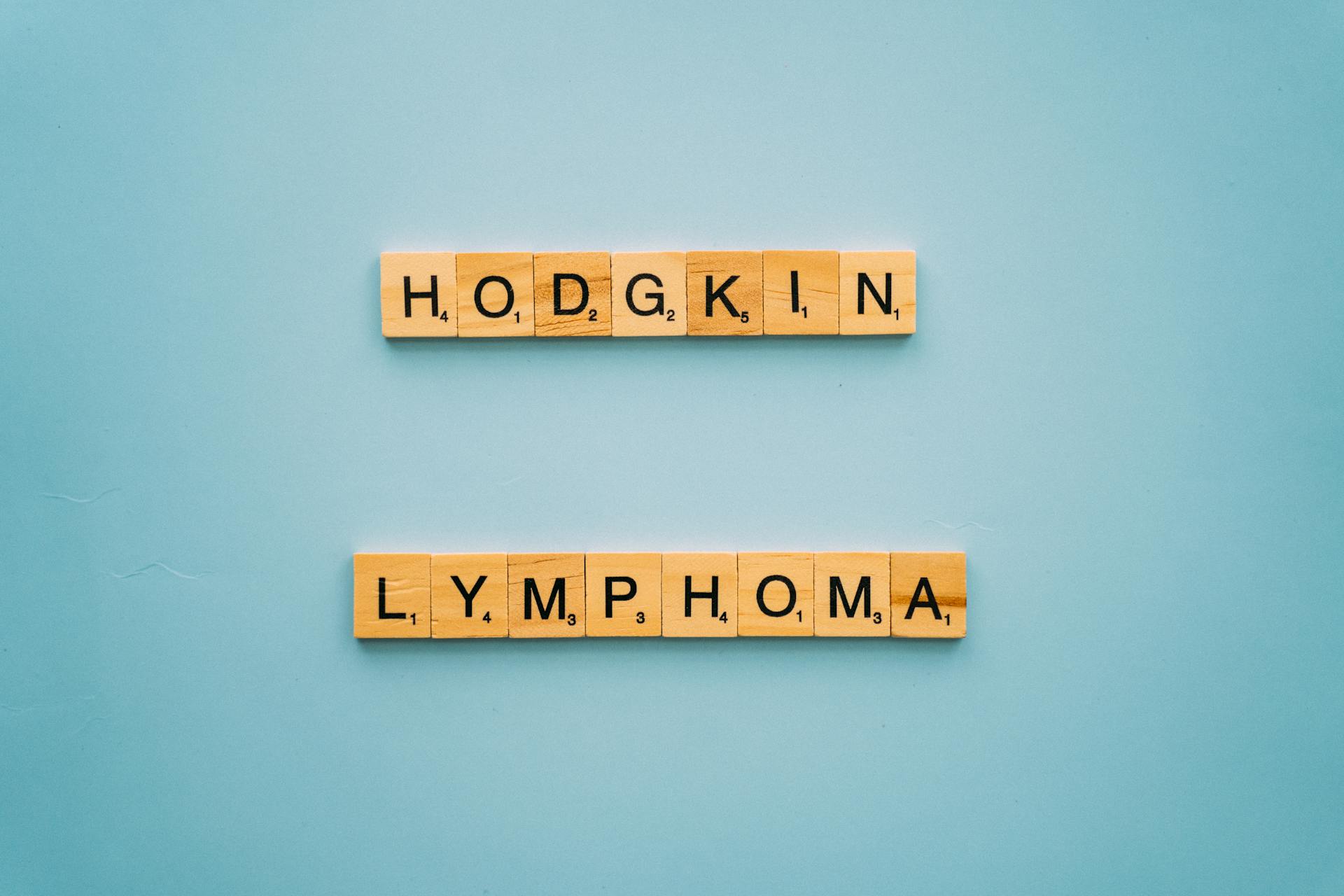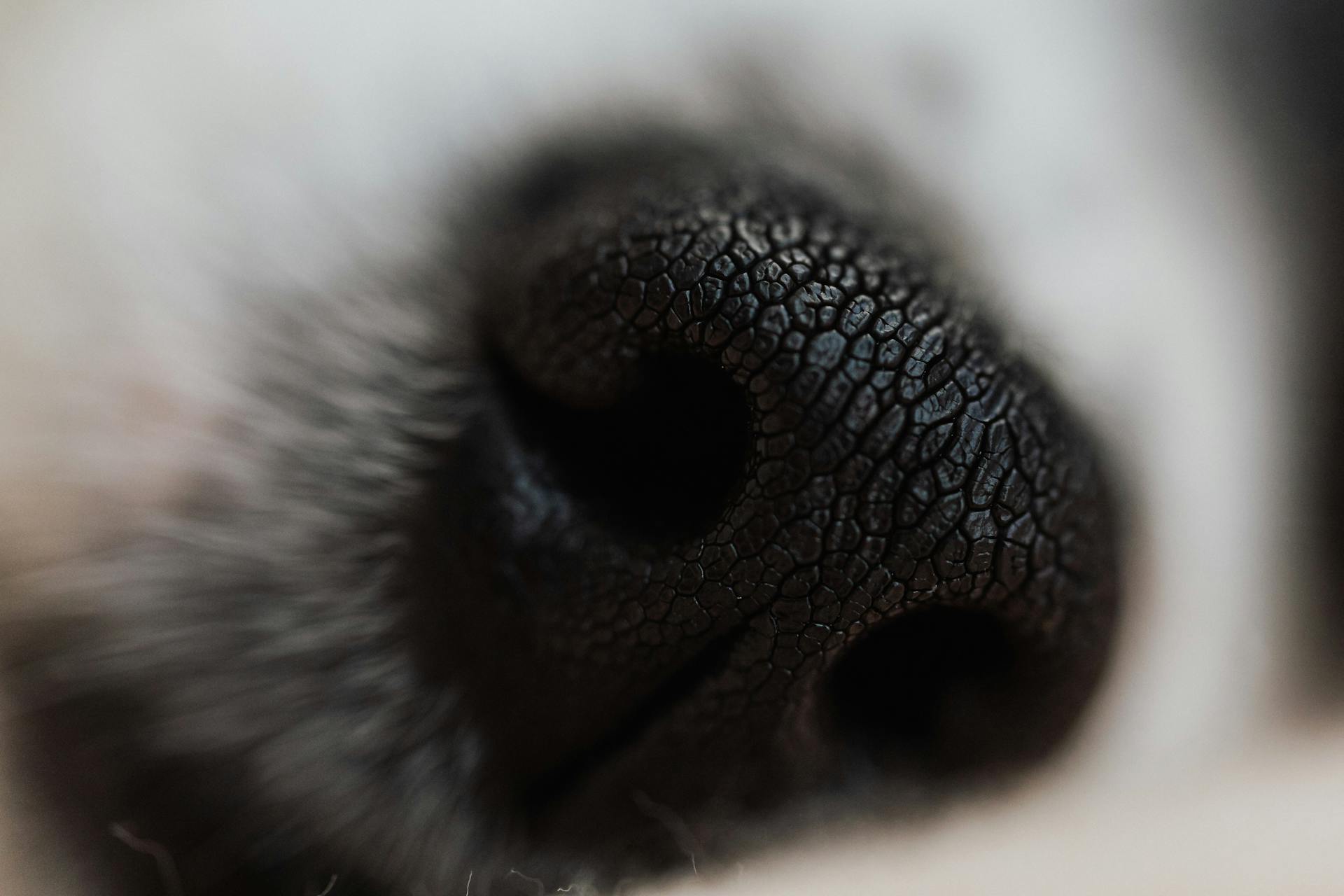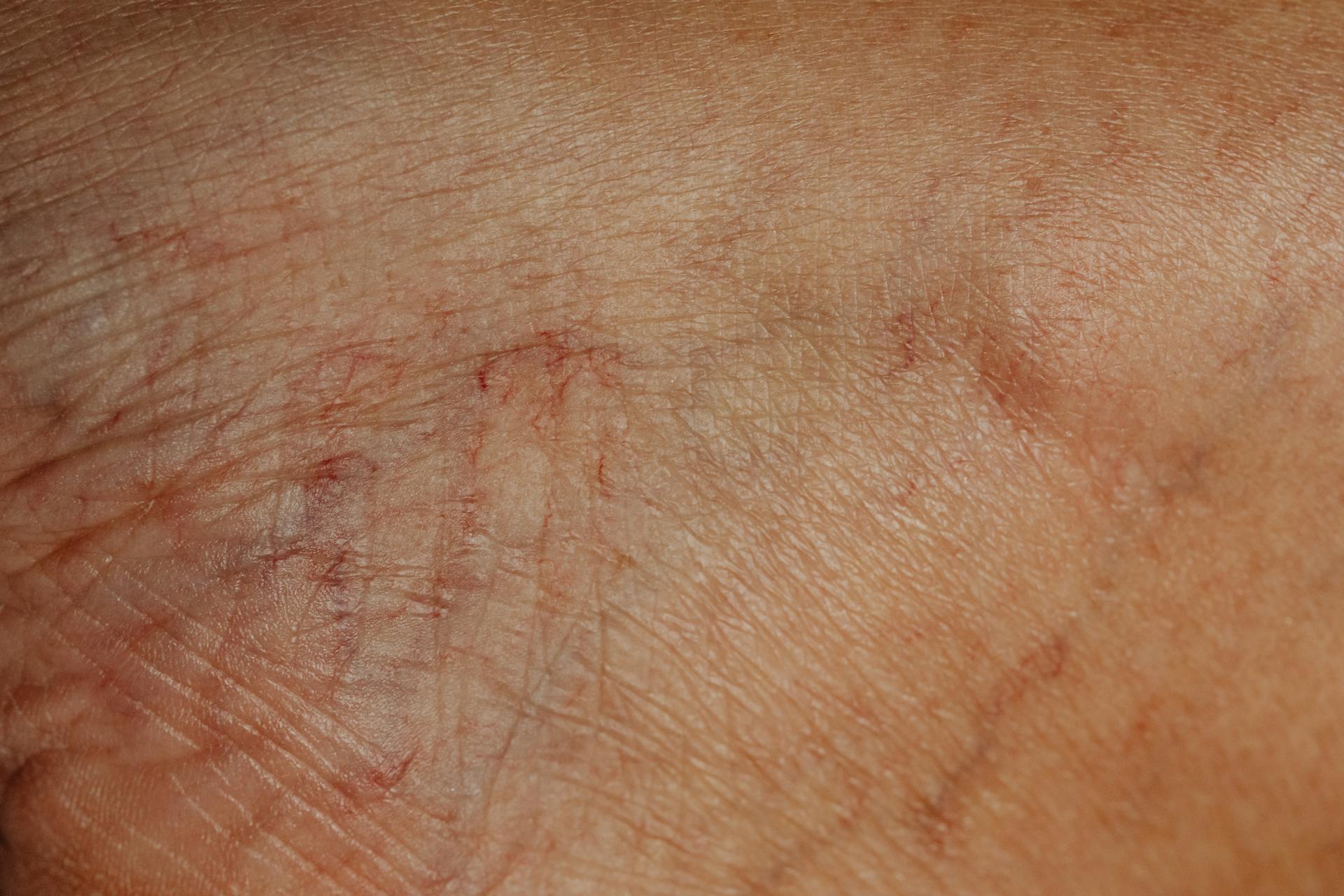
Cutaneous lymphoma in dogs is a serious condition that affects the skin, causing various symptoms such as hair loss, skin lesions, and redness.
The most common type of cutaneous lymphoma in dogs is the cutaneous T-cell lymphoma, which accounts for about 90% of cases.
Symptoms can appear suddenly or develop gradually, often starting on the face, legs, or trunk of the dog.
As a dog owner, it's essential to recognize the early signs of cutaneous lymphoma, such as skin lesions, hair loss, or redness, to seek veterinary care promptly.
Recommended read: Lymphoma Symptoms Dogs
What Is Lymphoma?
Lymphoma is a type of cancer that affects the immune system, specifically the lymphatic system, which is responsible for fighting off infections and diseases.
It's a complex condition that can be challenging to understand, but essentially, lymphoma occurs when the normal cells in the lymphatic system start to grow and multiply abnormally, forming tumors.
Cutaneous lymphoma in dogs is a type of lymphoma that affects the skin, causing a range of symptoms from skin lesions and lumps to hair loss and skin thickening.
The exact cause of cutaneous lymphoma is still unknown, but research suggests that it may be linked to genetic mutations and environmental factors.
Lymphoma can affect any breed of dog, but some breeds such as the Siberian Husky, Alaskan Malamute, and Labrador Retriever are more prone to developing the condition.
The symptoms of cutaneous lymphoma can vary depending on the type and stage of the disease, but common signs include skin lesions, lumps, and hair loss.
In some cases, cutaneous lymphoma can be a sign of a more serious underlying condition, such as a genetic disorder or a weakened immune system.
Causes and Symptoms
Cutaneous lymphoma in dogs can be a challenging condition to diagnose and manage. The symptoms can vary, but common signs include peeling skin, lesions and ulceration, and the skin may be itchy.
If your dog is experiencing hair loss, thickened skin, or oozing of fluid, it's essential to seek veterinary attention. These symptoms are often accompanied by plaques and a lack of response to antibiotics.
Some possible causes of cutaneous lymphoma in dogs include environmental factors, dietary factors, and exposure to toxins. Certain breeds may also be predisposed to this condition.
Causes of Cancer

Lymphocytes are a type of white blood cell that plays a crucial role in the immune system. They are found all over the body, including the skin, and are essential in defending the body against disease.
Certain areas of the body, such as lymph nodes, are rich in lymphocytes. These areas are particularly susceptible to abnormal replication of lymphocytes, which can lead to cancer.
Cutaneous lymphoma is a type of skin cancer that occurs within abnormal T-cells of the dog. It's a rare form of cancer that affects the peripheral blood and internal organs.
Research has shown that cutaneous lymphoma responds well to treatments, although there is no cure. A skin biopsy is the only way to determine if a dog has this disease.
The causes of cutaneous lymphoma in dogs are multifaceted and not fully understood. However, it's believed to be linked to environmental factors, dietary factors, lifestyle, exposure to toxins, and predisposition in certain breeds.
Here are some possible causes of cutaneous lymphoma in dogs:
- Environmental factors
- Dietary factors
- Lifestyle
- Exposure to toxins
- Predisposition in certain breeds
Symptoms

Symptoms of cutaneous lymphoma in dogs can be quite concerning for pet owners. Peeling skin is a common symptom, and it's often accompanied by lesions and ulceration.
Lesions and ulceration can be painful for dogs, causing discomfort and itching. The skin may be itchy due to the lesions and ulceration.
Plaques can also form on the skin, which can be a sign of cutaneous lymphoma. Hair loss is another symptom, and it's often accompanied by thickened skin.
Oozing of fluid from the skin can be a sign that the condition is progressing. If your dog is not responding to antibiotics, it could be a sign of cutaneous lymphoma.
Possible presence of oral lesions (gum and lips) is another symptom to look out for.
Diagnosis and Treatment
Diagnosis of cutaneous lymphoma in dogs typically begins with a veterinarian conducting laboratory tests, such as blood work, urinalysis, and biochemistry profile, to identify any underlying conditions.
Your veterinarian will also examine your dog's skin and may perform a biopsy to collect a sample of the affected skin for further examination.
Fine needle aspiration of the lesions or nearby lymph nodes can also be used to examine the cells and look for cancerous lymphocytes.
Baseline blood and urine tests are also conducted to look for abnormalities in the body's systems.
Chest or abdominal x-rays may be taken to check for potential tumor spread.
A biopsy of the skin, specifically a surgical excision of a piece of the tumor, is the most accurate way to make a definitive diagnosis of cutaneous lymphoma.
The biopsy is then examined by a veterinary pathologist under the microscope.
The pathologist looks for cancerous lymphocytes that support the diagnosis of lymphoma.
Treatment for cutaneous lymphoma in dogs typically involves chemotherapy, which can be administered intravenously or orally.
The most effective therapy for most types of canine lymphoma is chemotherapy, which can achieve remission of the cancer.
However, chemotherapy may have side effects, such as bone marrow suppression and gastrointestinal effects like vomiting and diarrhea.
A combination of chemotherapy drugs given over a six-month period is considered the "gold standard" for treating canine multicentric lymphoma.
The CHOP protocol, which involves a 25-week treatment plan, is commonly used to treat lymphoma in humans and is also effective in dogs.
Diagnosis

If you suspect your dog may have cutaneous lymphoma, your veterinarian will ask questions about your dog's symptoms and perform some initial tests.
Your veterinarian will likely start by conducting blood work, urinalysis, and a biochemistry profile to check for any underlying issues.
A biopsy may be performed to examine the affected skin, which can be done through a fine-needle aspiration or by removing a patch of skin for further examination.
In addition to a biopsy, your veterinarian may check for fungal or bacterial infections and perform an x-ray or ultrasound to check for any underlying disorders.
To confirm the diagnosis, a biopsy is the most accurate method, as it involves examining the tumor under a microscope.
A biopsy can be done by surgically excising a piece of the tumor, which is then examined by a veterinary pathologist.
Other tests that may be performed include fine-needle aspiration of the lesions or nearby lymph nodes, baseline blood and urine tests, chest or abdominal x-rays, and PCR testing to help differentiate cancerous lymphocytes from normal but reactive ones.
Here are some of the tests that may be performed to diagnose cutaneous lymphoma:
- Biopsy with histopathology
- Fine-needle aspiration of the lesions or nearby lymph nodes
- Baseline blood and urine tests
- Chest or abdominal x-rays
- PCR testing to help differentiate cancerous lymphocytes from normal but reactive ones
Treatment of
Treatment of cutaneous lymphoma in dogs typically involves a combination of chemotherapy, radiation therapy, and supportive care. Chemotherapy is often the most effective treatment option, and your veterinarian will discuss the types of therapy best suited for your dog's disease.
Curious to learn more? Check out: Are Therapy Dogs Service Dogs
The most effective chemotherapy protocol for canine multicentric lymphoma is a 25-week protocol called CHOP, which involves a combination of chemotherapy drugs given over a six-month period. This protocol has achieved the highest rates of remission and longest overall survival times for dogs with this type of lymphoma.
Chemotherapy for cutaneous lymphoma may be administered intravenously or orally, and the most effective drug for this type of lymphoma is thought to be lomustine (CCNU), a type of oral chemotherapy. Your veterinarian will help you decide on a chemotherapy treatment protocol that is appropriate for your dog.
Side effects of chemotherapy in dogs are generally mild and uncommon, with fewer than 5% of dogs experiencing side effects that need to be managed in a hospital setting. The most common side effects include loss of appetite, decreased activity level, and mild vomiting or diarrhea that persists for one or two days.
Dogs may experience hair loss or a condition known as "chemo coat" due to chemotherapy, especially those breeds with consistently growing hair such as Poodles, Shih Tzus, and Golden Retrievers. Hair growth will resume once chemotherapy is discontinued.
Your veterinarian will discuss alternative chemotherapy options or supportive care protocols if your dog no longer responds to therapy, including retinoids, linoleic acid, interferon, or prednisone. In some cases, surgical removal of the lesion or radiation therapy may be helpful if your dog develops a single, localized lesion.
Frequently Asked Questions
What is the life expectancy of a dog with epitheliotropic lymphoma?
The life expectancy of a dog with epitheliotropic lymphoma is typically 5-10 months, although some dogs may live longer with slow disease progression. Early diagnosis and treatment can impact a dog's quality of life and potentially extend its lifespan.
How fast does cutaneous lymphoma spread?
Cutaneous T-cell lymphoma (CTCL) can spread slowly over long periods, but in some cases it can progress quickly. Treatment is available to manage the condition
What are the final stages of cutaneous lymphoma in dogs?
The final stages of cutaneous lymphoma in dogs are characterized by severe symptoms such as labored breathing, incontinence, and complete loss of appetite. If you suspect your dog is experiencing these symptoms, seek veterinary care immediately.
What does cutaneous lymphoma rash look like?
A cutaneous lymphoma rash typically appears as a red or purple itchy rash with small pimples or flat areas that may be raised or lowered. If you're concerned about a skin rash, it's essential to consult a doctor for proper diagnosis and treatment.
What is the survival rate for dogs with T-cell lymphoma?
Dogs with T-cell lymphoma typically live 6-9 months, with 50% living longer and 50% passing away within that timeframe. With oral steroids alone, the prognosis is much shorter, lasting only 1-2 months.
Featured Images: pexels.com


